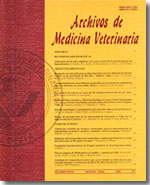Age related effect on proteoglycans size in equine articular cartilage
Main Article Content
Abstract
The aim of this study was to evaluate the effect of age on proteoglycans size in equine articular cartilage. Cartilage samples were obtained from metacarpophalangeal joints of crossbred equines inmediatelly after slaughter, and alloted in three groups according to the equines age: 1.5-2 years (n = 7); 4-5 years (n = 6) and over 10 years (n = 4). The cartilage extracts (100 mg /pair joints) were pooled for each age group and fractionated by exclution and ion exchange gel chromatography. Proteoglycan content of each fraction was determined by colorimetric reaction with safranine-O. The elution profile of Sepharose CL-2B, showed that proteoglycans appear as an polydisperse population of different size and similar molecular mass per age group. The size of proteoglycans decreased with age. A similar result was obtained measuring molecular mass and hydrodynamic radio values of proteoglycans when maximal absorbance values of each age group were used. These results show an inverse relationship between age and proteoglycans size of equine articular cartilage, which could affect the cartilage ability to undergo reversible compression.

